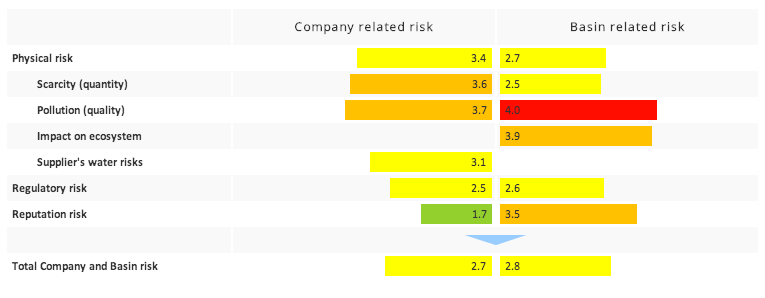WWF - The Water Risk Filter
The first tool to quantify water-related risks for all industries and all countries.
Water, or the lack of it, can directly affect companies' profitability and, in turn, investor confidence. In the worst cases, poor water management can force closure or relocation of business operations. Yet, when it comes to dealing with water issues, many companies don't know where to start. This tool helps companies and investors ask the right questions about water.
It allows you to assess the risks and offer guidance on what to do in response.
More than 1,500 organizations from 32 industry sectors have assessed facilities located in almost all of the 405 largest river basins, as well in hundreds of smaller basins all over the world. You can look at specific facilities or agricultural commodities, each with an automated basin assessment and questionnaire to evaluate direct operations.
Contents
[hide]When should I use the Water Risk Filter
For a company, The Water Risk Filter can be used to assess water related risks for your own operations, suppliers or growth plans. Regular re-assessments (annually) can show positive or negative trends. Also it can be used to make strategic (long term) choices on your supply chain. The results of the risk assessment and the provided possible mitigation responses will provide you with guidance on where to focus on, including actions and programmes that can be initiated with suppliers or other companies.
For an investor or creditor, a risk assessment can help identify potentially significant risks for your client and therefore your return on investment. This can be done at both the due diligence phase as well as once the client company is part of the portfolio. This information can lead to technical advice to clients on how to better manage water risk as well as pre-conditions for loans and investments.
Example: QUALI-LAIT
This industry example is for agricultural use in the Loire region of France.
The Water Risk Filter instructions
The Water Risk Filter is an online application for corporate officers, facility managers, and investors to analyze the impact of their business activity on the water supply, understand potential risk exposures, and obtain ideas for mitigating risk in a proactive way.
To use the Water Risk Filter, browse to www.waterriskfilter.panda.org. We recommend that you use Internet Explorer 7 or higher, Mozilla Firefox 9 or higher, the latest version of the Google Chrome, or Safari 5 browser with pop-ups enabled.
Site structure
The Water Risk Filter contains five main areas. Access these areas using the navigation bar near the top the pages of the site.
- Home. This page provides general information about the tool as well as links to the user guide a video tutorial, the FAQs, and more information on water stewardship.
- Quick View. This area of the site enables you to assess a facility’s basin-related and company-related risks based on GPS location and industry. Depending on the assessment score, the site might suggest a full assessment for a more detailed company-specific risk report.
- Full Assessment. This area of the site contains a tailored questionnaire for calculating a facility’s specific basin--related and facility-related water risk. You can present results with different details and populate reports.
- Maps. This area of the site enables you to choose from various map overlays, such as water scarcity, biodiversity, and climate change. You may also access a complete list of country profiles to give you a more thorough understanding of water issues in places of key interest.
- Mitigation. This area of the site provides information concerning response to risk. While risk scores are not prescriptive about the specific actions that you should take, the Mitigation section structures your response along the steps of stewardship and the three risk categories of the Water Risk Filter. You can also access a full set of references and support materials for each step as well as links to relevant case studies based on publicly available examples. These case studies enable you to explore how other companies have begun to tackle water issues.
- Knowledge Base. This area of the site provides access to supporting information. Learn about water stewardship initiatives, browse a list of key publications, and access a complete country profile database.
| User Manual |
Acknowledgements
- The Water Risk Filter. World Wildlife Fund (WWF).


